Themed collection Editors' collection: Chemical Biology

Novel designed azo substituted semi-cyanine fluorescent probe for cytochrome P450 reductase detection and hypoxia imaging in cancer cells
An NIR hypoxia activated fluorescent probe was designed with fast performance and sensitivity response to hypoxic conditions.
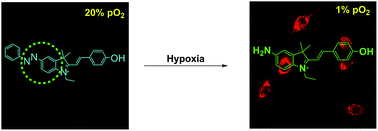
RSC Adv., 2019,9, 21572-21577
https://doi.org/10.1039/C9RA02741F
Aza-BODIPY probe for selective visualization of cyclooxygenase-2 in cancer cells
A bivalent indomethacin/Aza-BODIPY conjugate can selectively visualize the COX-2 enzyme in cancer and inflamed cells confirming its potential as a COX-2-specific biomarker in clinical applications.
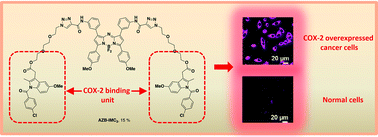
RSC Adv., 2019,9, 13372-13377
https://doi.org/10.1039/C9RA01948K
Antibacterial activity and mechanism of action of a thiophenyl substituted pyrimidine derivative
F20 exhibits strong antibacterial activity through interacting with FtsZ.
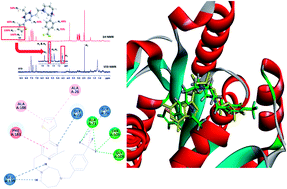
RSC Adv., 2019,9, 10739-10744
https://doi.org/10.1039/C9RA01001G
Discovery of human TyrRS inhibitors by structure-based virtual screening, structural optimization, and bioassays
A small molecule with potent activity diverts human Tyrosyl-tRNA synthetase (TyrRS) to the nucleus for protection against DNA damage.
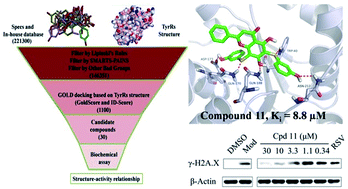
RSC Adv., 2019,9, 9323-9330
https://doi.org/10.1039/C9RA00458K
Insights into the stereoselectivity of human SETD7 methyltransferase
This work clearly reveals the interaction of SAM/hSET7/(R/S)-PFI-2 systems, and confirms that the different bioactive energy barriers of (R)-PFI-2 and (S)-PFI-2 lead to the tremendously different inhibitory activities between these two antipodes.
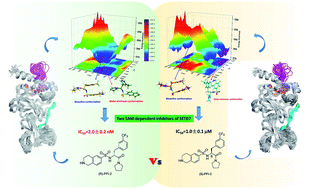
RSC Adv., 2019,9, 9218-9227
https://doi.org/10.1039/C9RA00190E
Novel cathepsin K inhibitors block osteoclasts in vitro and increase spinal bone density in zebrafish
Cathepsin K (Cat K) is a predominant cysteine protease and highly potent collagenase expressed in osteoclasts.
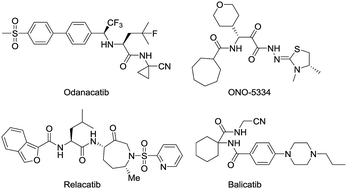
RSC Adv., 2019,9, 8600-8607
https://doi.org/10.1039/C8RA10338K
Synthesis, anti-mycobacterial and cytotoxic evaluation of substituted isoindoline-1,3-dione-4-aminoquinolines coupled via alkyl/amide linkers
A series of secondary amine-substituted isoindoline-1,3-dione-4-aminoquinolines were prepared via microwave heating and assayed for their anti-mycobacterial activities.
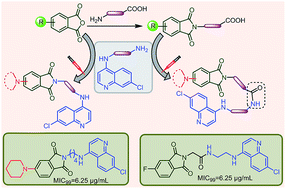
RSC Adv., 2019,9, 8515-8528
https://doi.org/10.1039/C8RA10532D
A lysosome-targetable fluorescent probe for the simultaneous sensing of Cys/Hcy and GSH from different emission channels
A novel lysosome targetable fluorescent probe, Lyso-AC, that can selectively sense lysosome Cys/Hcy and GSH from different emission channels was developed.

RSC Adv., 2019,9, 7955-7960
https://doi.org/10.1039/C9RA00210C
Design and synthesis of cysteine-specific labels for photo-crosslinking studies
The design and synthesis of cysteine specific diazirine containing labels is described.

RSC Adv., 2019,9, 7610-7614
https://doi.org/10.1039/C8RA10436K
tert-Butylphenylthiazoles with an oxadiazole linker: a novel orally bioavailable class of antibiotics exhibiting antibiofilm activity
The structure–activity and structure–kinetic relationships of a new tert-butylphenylthiazole series with oxadiazole linkers were conducted with the objective of obtaining a new orally available antibacterial compounds.
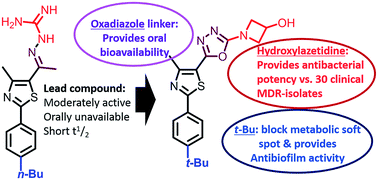
RSC Adv., 2019,9, 6770-6778
https://doi.org/10.1039/C8RA10525A
Discovery of trisubstituted nicotinonitrile derivatives as novel human GCN5 inhibitors through AlphaScreen-based high throughput screening
The trisubstituted nicotinonitrile derivative DC_HG24-01 was discovered as a novel potent hGCN5 inhibitor with efficient bioactivity against MV4-11 cells.

RSC Adv., 2019,9, 4917-4924
https://doi.org/10.1039/C8RA10074H
In vitro evaluation of anti-hepatoma activity of brevilin A: involvement of Stat3/Snail and Wnt/β-catenin pathways
Brevilin A, a natural sesquiterpene lactone extracted from Centipeda minima, has been found to exhibit anti-tumor effect.
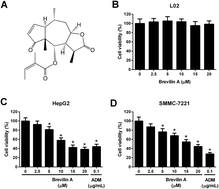
RSC Adv., 2019,9, 4390-4396
https://doi.org/10.1039/C8RA08574A
Effect of alternan versus chitosan on the biological properties of human mesenchymal stem cells
Alternan α-1,3- and α-1,6-linked glucan, promotes proliferation, migration, and differentiation of human MSCs.

RSC Adv., 2019,9, 4370-4379
https://doi.org/10.1039/C8RA10263E
Insight into the effect of quinic acid on biofilm formed by Staphylococcus aureus
QA effectively inhibited S. aureus biofilm formation. The key genes of biofilm inhibition induced by QA were agrA and sarA.
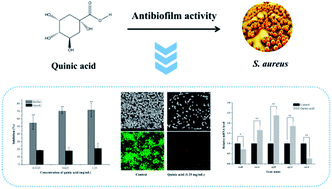
RSC Adv., 2019,9, 3938-3945
https://doi.org/10.1039/C8RA09136F
Synthesis and biological evaluation of 2,2-dimethylbenzopyran derivatives as potent neuroprotection agents
Novel compounds comprising 2,2-dimethylbenzopyran and cinnamic acid were synthesized. BN-07 significantly increased survival rate of primary neurons, superior to edaravone.

RSC Adv., 2019,9, 2498-2508
https://doi.org/10.1039/C8RA10424G
Site-specific labeling of an anti-MUC1 antibody: probing the effects of conjugation and linker chemistry on the internalization process
Four antibody conjugates were prepared to investigate how the conjugation and linker chemistry would impact ADC endocytosis and intracellular trafficking.

RSC Adv., 2019,9, 1909-1917
https://doi.org/10.1039/C8RA09902B
Design, synthesis and broad-spectrum Bcr-Abl inhibitory activity of novel thiazolamide–benzamide derivatives
3m showed good broad-spectrum Bcr-Abl inhibition of wild-type and T315I mutant.
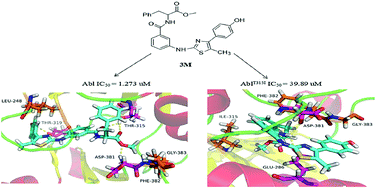
RSC Adv., 2019,9, 2092-2101
https://doi.org/10.1039/C8RA10096A
Discovery of novel elongator protein 2 inhibitors by compound library screening using surface plasmon resonance
This study employed a label-free high-throughput library screening method and verified a drug candidate to reduce TNF-α induced differentiation inhibition.
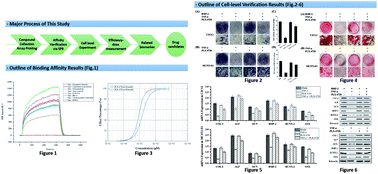
RSC Adv., 2019,9, 1696-1704
https://doi.org/10.1039/C8RA09640F
Tetra-fluorinated aromatic azide for highly efficient bioconjugation in living cells
A fast strain-promoted azide–alkyne cycloaddition based on tetra-fluorinated aromatic azide was developed and applied to label proteins and living cells with high efficiency.

RSC Adv., 2019,9, 23-26
https://doi.org/10.1039/C8RA09303B
2′-Deoxy-5-(hydroxymethyl)cytidine: estimation in human cancer cells with a simple chemosensor
A new chemosensor, CS-1, has been developed and characterized for the selective detection and quantification of 2′-deoxy-5-(hydroxymethyl)cytidine (5hmC) in human cancer cells.

RSC Adv., 2018,8, 39893-39896
https://doi.org/10.1039/C8RA08391F
Bufalin suppresses colorectal cancer cell growth through promoting autophagy in vivo and in vitro
Specific groups in Asia, including the Chinese, are more susceptible to colorectal cancer (CRC).
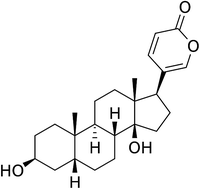
RSC Adv., 2018,8, 38910-38918
https://doi.org/10.1039/C8RA06566G
Halogen bonding for the design of inhibitors by targeting the S1 pocket of serine proteases
BrBA binds to the S1 pocket of urokinase with Br facing the base of the pocket by halogen bonds, while iodine of IBA binds to the S1 in the opposite way.
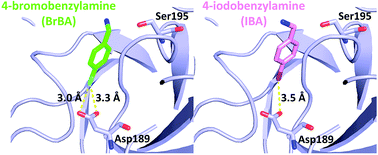
RSC Adv., 2018,8, 28189-28197
https://doi.org/10.1039/C8RA03145B
Compound F779-0434 causes synthetic lethality in BRCA2-deficient cancer cells by disrupting RAD52–ssDNA association
A novel compound named F779-0434 caused synthetic lethality in BRCA2-deficient cancer cells by disrupting RAD52–ssDNA associations.

RSC Adv., 2018,8, 18859-18869
https://doi.org/10.1039/C8RA01919C
Bicyclo[2.2.1]heptane containing N,N′-diarylsquaramide CXCR2 selective antagonists as anti-cancer metastasis agents
Novel bicyclo[2.2.1]heptane containing N,N′-diarylsquaramide CXCR2 selective antagonists were identified as potent anti-cancer metastatic agents.
![Graphical abstract: Bicyclo[2.2.1]heptane containing N,N′-diarylsquaramide CXCR2 selective antagonists as anti-cancer metastasis agents](/en/Image/Get?imageInfo.ImageType=GA&imageInfo.ImageIdentifier.ManuscriptID=C8RA01806E&imageInfo.ImageIdentifier.Year=2018)
RSC Adv., 2018,8, 11061-11069
https://doi.org/10.1039/C8RA01806E
Discovery of novel inhibitors of RNA silencing suppressor P19 based on virtual screening
The combined virtual and experimental screening method is a efficient strategy to discover inhibitors of RNA silencing suppressor.

RSC Adv., 2018,8, 10532-10540
https://doi.org/10.1039/C8RA01311J
Discovery and preliminary SAR of 14-aryloxy-andrographolide derivatives as antibacterial agents with immunosuppressant activity
6b17 and 9b are active against 3 tested bacteria while they block IL-6/STAT3, TLR4/NF-κB and TNF-α/NF-κB pathways. 7b1 and 8b1 are selectively active against E. faecalis but 7b1 selectively blocks TNF-α/NF-κB pathway and 8b1 selectively blocks TLR4/NF-κB pathway.
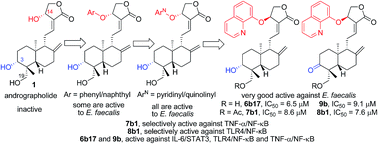
RSC Adv., 2018,8, 9440-9456
https://doi.org/10.1039/C8RA01063C
Discovery of N-cyclobutylaminoethoxyisoxazole derivatives as novel sigma-1 receptor ligands with neurite outgrowth efficacy in cells
Herein we reported a series of 14 novel derivatives based on the N-cyclobutylaminoethoxyisoxazole scaffold.

RSC Adv., 2018,8, 7080-7088
https://doi.org/10.1039/C8RA00072G
An innovative small molecule for promoting neuroreparative strategies
In this study, a new regenerative strategy to treat several neurodegenerative diseases is suggested by the use of a multitarget approach induced by our small molecule, MC111.

RSC Adv., 2018,8, 5451-5458
https://doi.org/10.1039/C7RA11812K
Gs protein peptidomimetics as allosteric modulators of the β2-adrenergic receptor
A series of Gs protein peptidomimetics were designed and synthesised based on the published X-ray crystal structure of the active state β2-adrenergic receptor (β2AR) in complex with the Gs protein (PDB 3SN6).
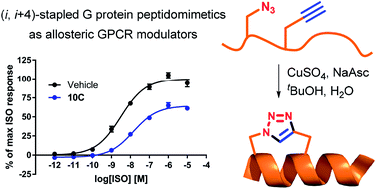
RSC Adv., 2018,8, 2219-2228
https://doi.org/10.1039/C7RA11713B
Novel spirocyclic tranylcypromine derivatives as lysine-specific demethylase 1 (LSD1) inhibitors
Herein we describe the design, synthesis, and biological evaluation of a novel series of tranylcypromine-based LSD1 inhibitors via conformational restriction using spiro ring systems.
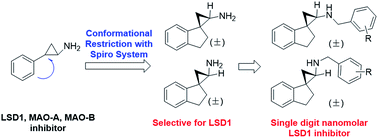
RSC Adv., 2018,8, 1666-1676
https://doi.org/10.1039/C7RA13097J
Nucleobase-modified antisense oligonucleotides containing 5-(phenyltriazol)-2′-deoxyuridine nucleotides induce exon-skipping in vitro
We investigated the potential of nucleobase-modified antisense oligonucleotides to induce exon-skipping, and found that 5-(phenyltriazol)-2′-deoxyuridine-modified antisense oligonucleotides induced efficient exon-skipping in vitro.

RSC Adv., 2017,7, 54542-54545
https://doi.org/10.1039/C7RA10964D
Selective recognition of c-myc promoter G-quadruplex and down-regulation of oncogene c-myc transcription in human cancer cells by 3,8a-disubstituted indolizinone
Indolizinone could selectively recognize c-myc promoter G-quadruplex.
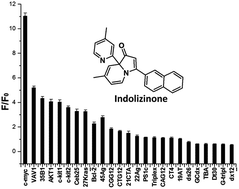
RSC Adv., 2017,7, 51965-51969
https://doi.org/10.1039/C7RA09870G
Development of a series of bis-triazoles as G-quadruplex ligands
Maintenance of telomeres – specialized complexes that protect the ends of chromosomes – is provided by the enzyme complex telomerase, which is a key factor that is activated in more than 80% of cancer cells, but absent in most normal cells.
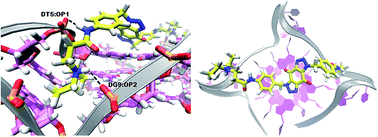
RSC Adv., 2017,7, 47297-47308
https://doi.org/10.1039/C7RA07257K
Hydrophobic tagging-mediated degradation of Alzheimer's disease related Tau
HyT-Tau-CPP reduced Tau levels in Alzheimer's disease (AD) mouse model, and appeared to be a promising candidate for AD treatment.
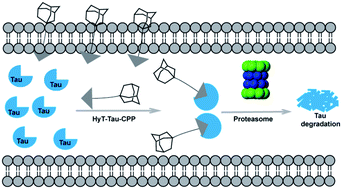
RSC Adv., 2017,7, 40362-40366
https://doi.org/10.1039/C7RA05347A
Evaluation of structure–activity relationships of ginsenosides against amyloid β induced pathological behaviours in transgenic Caenorhabditis elegans
The systematic in vivo study comparing the effects of different ginsenosides on Aβ induced toxicity and cognitive impairment.

RSC Adv., 2017,7, 40095-40104
https://doi.org/10.1039/C7RA05717B
About this collection
The use of chemical tools to explore biology has led to an explosion in new discoveries impacting cell biology and medicine. This includes the use of small molecules, peptides and natural products as chemical probes for the discovery of novel biology and validation of new therapeutic targets; the design of fluorescent probes for visualizing cellular and in vivo biology; and the development of new bioorthogonal chemistries with applicability to living systems.
This collection, guest edited by Associate Editor Amanda Garner (University of Michigan, USA), highlights exciting work in the area of chemical biology. It includes 35 recently published original research papers, in addition to 3 reviews, covering many areas related to the design, discovery and application of chemical tools to further our understanding of biology and medicine. This compilation serves as an excellent example of the high-quality and breadth of research that is showcased in RSC Advances, which will hopefully inspire new applications of chemistry to biological problems.